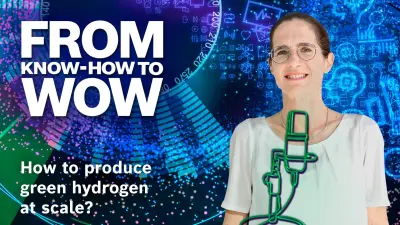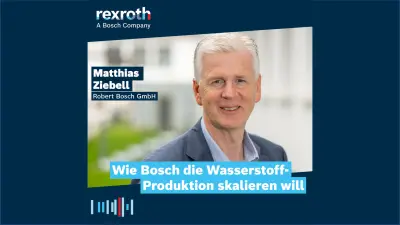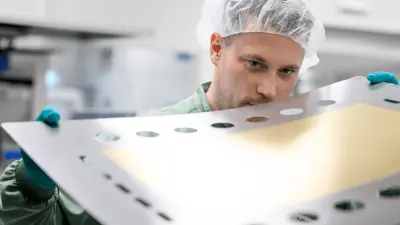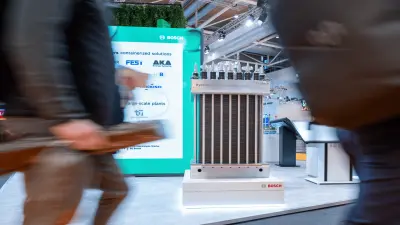Proton exchange membrane (PEM) water electrolysis for green hydrogen production
Advance your production of hydrogen with Hybrion PEM electrolysis stacks and services by Bosch.
Discover hydrogen production with Hybrion PEM Electrolysis Stacks
Dive into the world of hydrogen production and experience our Hybrion PEM electrolysis stacks in 3D. Explore interactively now:
Hydrogen produced via the proton exchange membrane electrolysis (PEMEL or PEM) method is one of the key elements of a low emission energy economy. It is generated in electrolysis systems powered by electricity with water as the raw material. The reaction products of this electrochemical process are hydrogen and oxygen.
Hybrion PEM Electrolysis Stacks in use
Hybrion stacks efficiently generate hydrogen for a mobility use case in Bamberg, Germany.

Loading the video requires your consent. If you agree by clicking on the Play icon, the video will load and data will be transmitted to Google as well as information will be accessed and stored by Google on your device. Google may be able to link these data or information with existing data.
FAQs about PEM electrolysis and our Hybrion PEM Electrolysis Stacks
Proton exchange membrane electrolysis (PEM electrolysis) is an electrochemical process for producing hydrogen by means of water electrolysis. The process uses an electrolyzer that contains an anode and a cathode. The anode and cathode are separated electrically by a proton exchange membrane, which is also called a polymer electrolyte membrane. When the electrolysis process runs on electricity from renewable energy sources such as solar power, hydropower, or wind power, the hydrogen produced is known as green hydrogen.
In PEM electrolysis, ultrapure water flows around a proton exchange membrane (PEM). Located between the anode and the cathode, this membrane is ionically conductive. When an electric voltage is applied to both electrodes, the water on the anode side oxidizes to oxygen, free electrons, and hydrogen ions (Oxygen Evolution Reaction, OER). The ions pass through the membrane by diffusion. They then combine with the electrons at the cathode side to form hydrogen gas (Hydrogen Evolution Reaction, HER). The reaction products of PEM electrolysis are hydrogen and oxygen.
A PEM electrolyzer is a system that splits water into its component parts of hydrogen and oxygen by means of an electrochemical reaction. The hydrogen produced in this way is used as an efficient energy source. We manufacture the most important component of a PEM electrolyzer – the stack, which is, in a sense, the beating heart of water electrolysis. There is a great range of areas of application – and the dimensions of electrolysis systems vary greatly, too. They range from decentralized hydrogen production for covering industrial companies’ own needs through to large-scale systems for industrial hydrogen applications or for companies that produce hydrogen on a large scale for export purposes.
A PEM stack is the most important component of a water electrolysis system, which we manufacture in industrialized series production. The stack splits water into oxygen (O₂) and hydrogen (H₂).
Our Hybrion stack consists of more than 100 cells. The Hybrion Stack produces 22.9 kg of hydrogen per hour at an output pressure of max. 34 bar. This is equivalent to a rated power of up to 1.25 megawatts. Each Hybrion stack weighs around 2,850 kg and measures 85 × 100 × 154 cm.
Compared to other electrolysis methods, such as alkaline electrolysis (AEL), PEM water electrolysis boasts a number of key benefits, including high power density, high energy efficiency, and high hydrogen output pressure. There are other advantages to using PEM electrolyzers, too – they offer maximum flexibility, require very little space, and can be scaled with ease. What’s more, this process is very safe and reliable, making it the ideal technology when combined with renewable energy resources such as wind and solar power.
In PEM electrolysis, ultrapure water flows around a proton exchange membrane (PEM). Located between the anode and the cathode, this membrane is ionically conductive. When an electric voltage is applied to both electrodes, the water on the anode side oxidizes to oxygen, free electrons, and hydrogen ions (Oxygen Evolution Reaction, OER). The ions pass through the membrane by diffusion. They then combine with the electrons at the cathode side to form hydrogen gas (Hydrogen Evolution Reaction, HER). The reaction products of PEM electrolysis are hydrogen and oxygen.
Green hydrogen is generated in electrolysis systems using water and electricity from renewable sources, such as solar or wind energy, with water as the raw material. In this way, electrolysis is particularly resource-saving.
Electrolysis-produced hydrogen is a true all-rounder in industrial processes, transport, and energy sectors, as it is an energy source, a raw material, and an energy storage medium all in one. In its molecular form, it is an energy source, and its potential can be used by converting it into electrons – in other words, it can be used to generate electricity. At the same time, it is gaseous and combustible, so it can be used as an alternative to fossil fuels.
Green hydrogen can be used to decarbonize industries that are unable to dispense with fossil fuels just by switching to electricity. Green hydrogen can also be used in the chemical industry. What’s more, when utilized as a fuel for commercial vehicles and rail vehicles and as a base product for synthetic fuels, hydrogen can play an important role in making the transport sector less dependent on fossil fuels.
Green Hydrogen can be stored, which opens up many possibilities for storing energy in this form on a long-term basis. One particularly promising application is power-to-gas. This involves converting electrical energy into hydrogen and storing it to make it available for a variety of uses. Green hydrogen therefore has the potential to make a key contribution to replacing natural gas, coal, and oil.
Compared to these forms of energy, the crucial difference is that a hydrogen economy is possible without any associated emissions, such as greenhouse gases.
The comissioning of Bosch Hybrion PEM electrolysis stacks for customers starts in 2025. All technical specifications given are development objectives and refer to the beginning of life.








